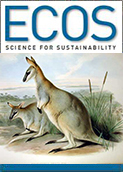
|
Published: 10 June 2014
More governments adopting controversial ‘triage’ approach to conservation
Governments in Australia and internationally are coming round to the idea of taking a ‘triage approach’ to conservation, according to the ARC Centre of Excellence for Environmental Decisions (CEED). This involves agencies focusing available resources on saving as many endangered species as possible, rather than trying to save fewer ‘living dead’ species.

|
|
A male superb parrot; this species is listed as threatened in Victoria and vulnerable in the Australian Capital Territory and New South Wales. The entire population may only be a few thousand birds. Credit:
Ron Knight
|
The concept of saving more species for the same cost, or triage, was proposed to the Australian Federal Government in 1999 by Professor Hugh Possingham, now Director of CEED.
Prof. Possingham says the NSW, Tasmanian and New Zealand governments have all adopted versions of conservation triage, and the Queensland and US governments are considering it.
‘Conservation triage is still a sensitive topic because it forces people to acknowledge that we don’t have enough resources to save all threatened species; that choices have to be made, even though we may not like making them,’ he says.
‘In an age of catastrophic decline in the Earth’s and Australia’s biodiversity, we need to acknowledge that the resources we are currently devoting to conservation are not going to save everything.
‘If that’s the case, you have to take a decision what you are going to save – and which species will most repay your efforts to save them. Otherwise you end up spending scarce resource on species you cannot save – and have too little left to save those you probably could have rescued.’
Associate Professor Michael McCarthy, deputy director of CEED, rejects the claims of some environmental groups that adopting a triage policy ‘makes extinction acceptable’.
‘It certainly doesn’t,’ Dr McCarthy says. ‘Instead it forces us to ask: can we save this animal? How much will it cost to do so? How important is it to its ecosystem? And does the community care enough about it to help in the fight to save it?
‘Importantly, triage is not about letting the most endangered species go extinct, it is wisely choosing those species which have the best chance of recovery, rationally accounting for cost and chance of success. The most threatened species may well be the ones that receive most investment.’
Dr McCarthy says triage forces society to acknowledge it is better to save the things it can, rather than devote scarce resources to those it cannot.
‘It also makes the decision about what to save a more public one, which requires society to take greater responsibility for it, instead of decisions being taken behind closed doors.’
Prof. Possingham says that, at a time of limited government funding for conservation, the public will have to shoulder a greater load if it cares about preserving species for its grandchildren.
‘We have some great examples where the community has rallied round to save particular species – an example is the public effort in southern Queensland to save the Richmond birdwing butterfly by replanting the native vines that it feeds and depends on,’ he says.
‘At the moment, governments don’t tell us which species they are not funding – only the ones they are,’ he notes. ‘Under triage you publish the priority funding tables, and the community can then decide where to help.
Source: CEED



